
Email Marketing Customer Journey: An Essential Guide [2025]
Brands always look for effective ways to guide consumers through the customer journey, from awareness to loyalty. Email marketing is one of the most powerful tools for achieving this.
Email can seamlessly engage customers at every stage of their journey by delivering personalized, timely messages, driving meaningful connections, and measurable results.
In this essential guide, we’ll go through everything you need to know about mapping your email marketing customer journey and all the benefits it can bring to your business.
What is the Email Marketing Customer Journey?
The customer journey is the process a customer goes through, from first learning about your brand to making a purchase. It includes key stages like awareness, consideration, purchase, and loyalty.
An email customer journey focuses on how email supports this process. You can guide customers at every stage through targeted campaigns—raising awareness with introductions, nurturing consideration with educational content, driving purchases through offers, and building loyalty with personalized follow-ups and retention emails.
By mapping this journey, you can create a cohesive SaaS content strategy that engages customers at the right time with the right message.
Benefits of Mapping the Customer Journey in Email Marketing
The email marketing customer journey is all about building connections with your customers through targeted email campaigns.
Creating a map lets you see the key touchpoints along that journey and target the right emails to customers at the right time.
Before we see how to plan one, let’s look at some of its advantages.
Offers personalized experiences
Email personalization is a powerful tool to understand and segment your audience effectively. This way, you can deliver more tailored messages that resonate with their needs.
For example, if Mary is in the post-purchase stage, you can send her a purchase confirmation, delivery updates, and related product offers.
On the other hand, John, in the consideration stage, might receive personalized welcome emails or first-time discounts that encourage him to take the next step.
Mapping the journey ensures your email campaigns align with customer demographics, behaviors, and needs, creating a seamless and engaging experience.
Improve customer satisfaction and loyalty
Mapping the customer journey will allow you to identify pain points and opportunities you can address later with targeted content.
For example, if a customer frequently abandons their cart, you can send an email highlighting the benefits of the product they left behind, perhaps paired with a limited-time discount or free shipping offer.
When you tailor your emails to appeal to customers’ pain points, they feel like you understand their hopes, problems, and day-to-day lives.
The result? You increase customer satisfaction, align your marketing efforts with customer needs, and turn them into loyal shoppers who rely on you for solutions.
Collect insights for future marketing strategies
Did you know the email marketing customer journey is a valuable roadmap for marketing teams to follow, analyze, and refine?
Gathering data and insights can continuously improve your email marketing strategies. Let’s explore how key metrics can drive your success.
- Open rates: If you notice that emails with personalized subject lines have significantly higher open rates, you can prioritize personalization in future campaigns.
- Click-through rates (CTR): Analyze which CTAs drive the most clicks. For instance, if “Shop Now” consistently outperforms “Learn More,” you can adjust your language accordingly.
- Abandoned cart recovery: If data shows that offering a 10% discount in follow-up emails recovers more carts than free shipping, you can adjust your strategy for higher conversions.
- Engagement by stage: If you see a drop-off in engagement during the consideration phase, you might introduce new content, like testimonials or case studies, to re-engage customers.
These insights will allow you to optimize your email customer journey and offer new leads more reasons to move further down your email marketing funnel.
How to Map the Email Marketing Customer Journey
Now that we’ve talked about the benefits, let’s see how to plan your roadmap.
1. Create a detailed profile of your ideal customer
Customer profiles, or personas, are essential for mapping the email customer journey. They help you segment your audience and create tailored email campaigns that address specific needs and behaviors.
To build a customer profile, consider who your product or service appeals to the most. You can use data from your existing customers to enrich these profiles, such as demographics, email engagement patterns, and pain points.
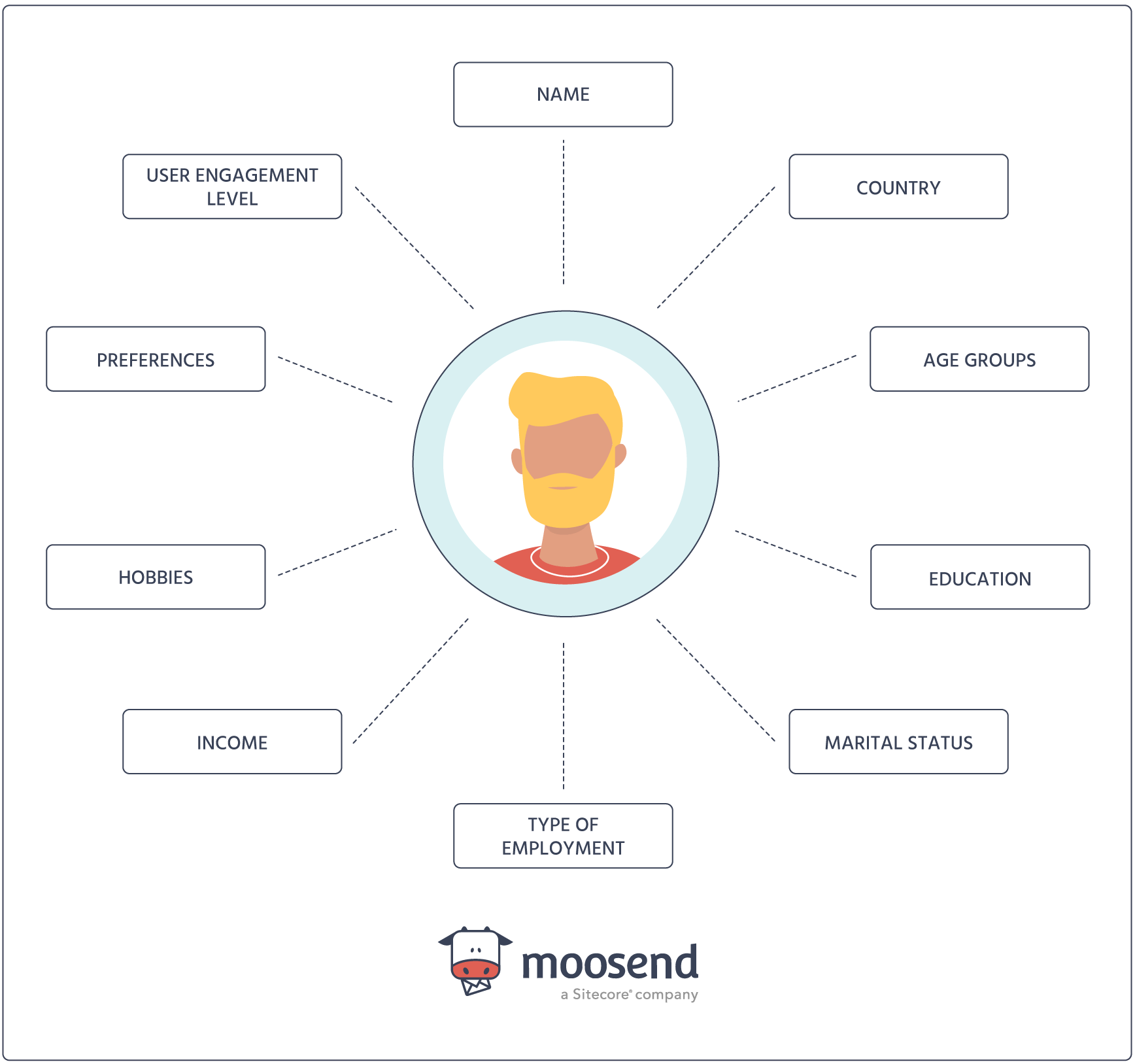
For email marketing, a detailed customer profile should include:
- Who they are: Age, gender, location, socioeconomic status, values, etc.
- Their day-to-day life: Career, hobbies, family life, and lifestyle preferences.
- Pain points and goals: What challenges do they face, and how can your emails address these struggles to help them achieve their goals?
- Email behavior: How they interact with your emails—open rates, click-throughs, and the types of content they engage with.
- Purchasing habits: Frequency of purchases, average order value, and preferred products or services.
You can create as many customer profiles as you need to address various groups within your target audience.
Further reading: For more, check out our dedicated customer personas guide,
2. Break it down into more distinct stages
Depending on your business model, there are many ways to interpret the customer journey. For example, a B2B SaaS company’s journey will differ from a B2C fashion retailer.
Here’s a standard customer journey example:
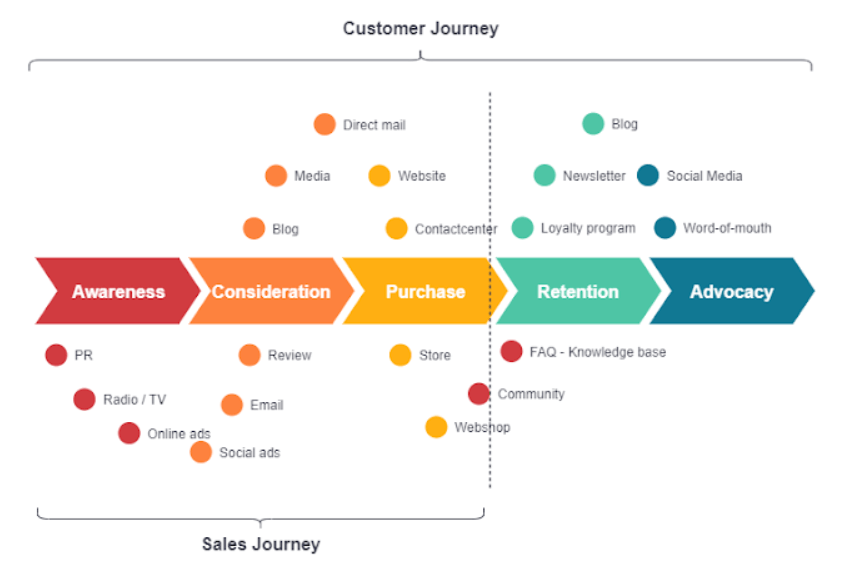
Most email marketing customer journeys include the stages of awareness, consideration, purchase, and retention, with re-engagement as an additional stage.
To map an effective journey, let’s see each stage separately.
- Awareness stage: Potential customers first encounter your brand. Emails introduce your business, educate, and build initial trust, often triggered by actions like newsletter sign-ups or resource downloads.
- Consideration stage: Customers are evaluating their options. Emails highlight product features, address pain points, and build confidence, helping them move closer to a decision.
- Purchase stage: This stage focuses on converting interest into action. Emails ensure smooth transactions with confirmations, updates, and recommendations for related products or services.
- Loyalty stage: After a purchase, emails can build long-term relationships through personalized follow-ups, loyalty rewards, and exclusive offers, encouraging repeat engagement.
- Re-Engagement stage: Inactive customers are encouraged to reconnect through emails with incentives, updates, or reminders of your brand’s value, bringing them back into the journey.
3. List customer interactions, pain points, and feelings
The email marketing customer journey involves various touchpoints where customers interact with your brand.
Identifying these interactions is crucial for sending targeted emails at the right moment for a seamless and engaging experience.
You can organize them according to each stage. Here’s an example with potential interactions for each step.
Awareness stage
- Visiting your website or landing pages
- Searching for your product or service online
- Clicking on online ads
- Following your brand on social media
- Signing up for your newsletter, demo, or free trial
Consideration stage
- Browsing your product pages or pricing section
- Downloading resources like ebooks or whitepapers
- Attending a webinar or live demo
- Adding items to their cart but not checking out
- Asking questions via chatbots or customer support\
Purchase stage
- Completing an order or signing up for a subscription
- Using a discount code or special offer
Loyalty stage
- Leaving product reviews or ratings
- Engaging with loyalty or rewards programs
- Following your social media for updates or promotions
Re-engagement emails
- Inactive accounts
- Unopened emails
Apart from their interactions and pain points, you need to understand your customers’ mindset and emotions at each stage. This way, you’ll create messages that fully resonate with them.
For example, customers in the awareness stage may be curious and unsure about your brand, while those in the purchase stage may be excited but still have questions or doubts.
4. Find the right email opportunities for each stage
Each stage of the email customer journey requires tailored opportunities to align with the customer’s mindset and level of engagement.
Sending the wrong type of email at the wrong time—such as a hard sell at the awareness stage—can alienate potential customers. Here’s how to match email opportunities with the appropriate stage:
Awareness:
- Welcome emails: Introduce your brand and set expectations for future communications.
- Educational campaigns: Share helpful resources like blog posts, guides, or explainer videos.
- Free trials/resources: Encourage engagement by offering free trials or downloadable content.
Consideration:
- Product recommendations: Highlight items or services they’ve shown interest in.
- Case Studies and testimonials: Build credibility with success stories.
- Cart abandonment emails: Gently remind customers of items left in their cart, adding incentives like free shipping or discounts.
- Follow-up emails: After webinars, demos, or trials, provide additional resources and suggest the next steps.
Purchase:
- Order confirmations: Reassure customers their purchase was successful.
- Delivery updates: Keep them informed and build anticipation for their order.
- Upsell or cross-sell emails: Suggest complementary products or services once the purchase is confirmed.
- Limited-time offers: Encourage additional purchases with urgent deals.
Loyalty:
- Thank-you messages: Express gratitude for their loyalty.
- Loyalty rewards: Highlight points earned, perks, or upcoming rewards.
- VIP invitations: Offer access to exclusive programs, events, or products.
- Post-purchase surveys: Show you value their feedback and want to improve their experience.
Re-engagement:
- Re-engagement campaigns: Send “We miss you!” emails with incentives.
- New product/feature announcements: Highlight updates that align with their past interests.
- Discounts for returning customers: Provide personalized offers to encourage re-engagement.
With the right email content, you can target each stage effectively and minimize mistakes and lost opportunities.
5. Use a visual tool to depict the customer journey
Visualizing the customer journey simplifies complex data and helps your team understand how customers move through each stage, from awareness to re-engagement.
Start by mapping out stages and touchpoints, such as sign-ups, purchases, and feedback. Include key customer actions and emotions to provide a complete view. For instance, a flowchart can show how a welcome email leads to a product page visit, followed by a consideration email offering a discount.
Tools like Canva or journey mapping software make creating and customizing visuals easy.
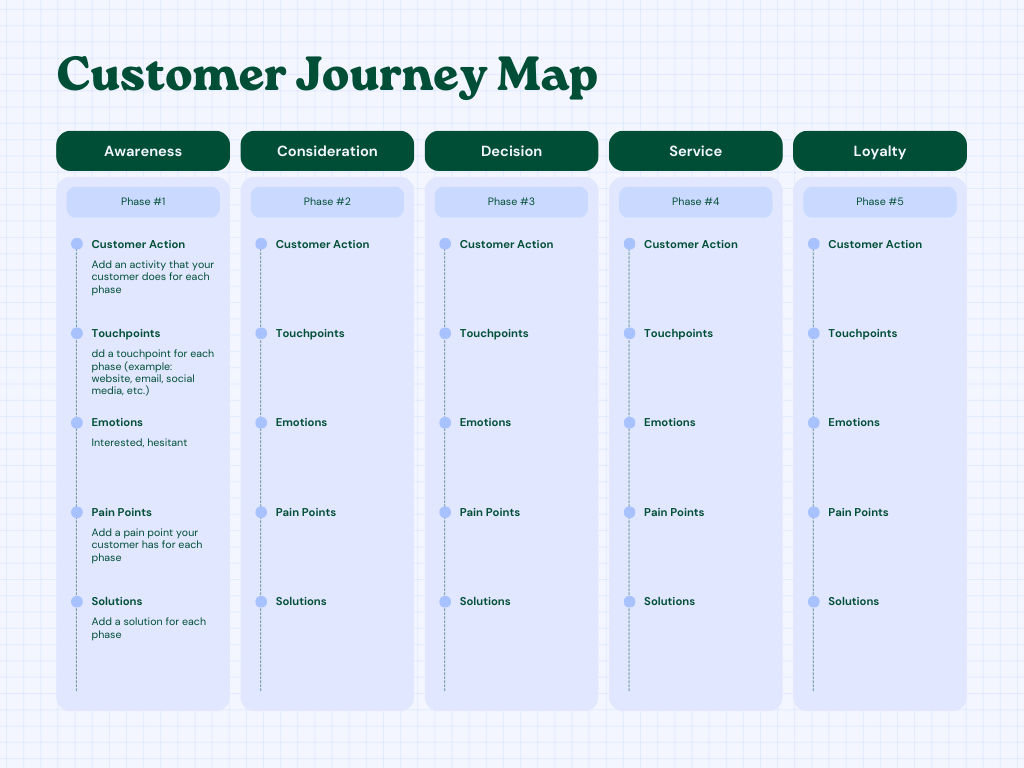
A clear map aligns your team, highlights gaps, and identifies opportunities to optimize the customer experience, ensuring every email drives engagement and results.
Tips to Enhance the Email Marketing Customer Journey
Here are some extra email tips to help create a more positive, streamlined, and satisfactory customer journey.
Segment your audience
You can deliver more relevant and impactful campaigns by dividing your email list into meaningful segments based on shared characteristics or behaviors.
Email segmentation ensures that each customer gets emails that feel personal and relevant. For example, new subscribers are more likely to convert when offered a welcome discount, while loyal customers respond better to exclusive perks.
This targeted approach increases open rates, click-through rates, and overall engagement while reducing unsubscribes.
You can segment your audience through your email marketing platform throughout the customer journey.
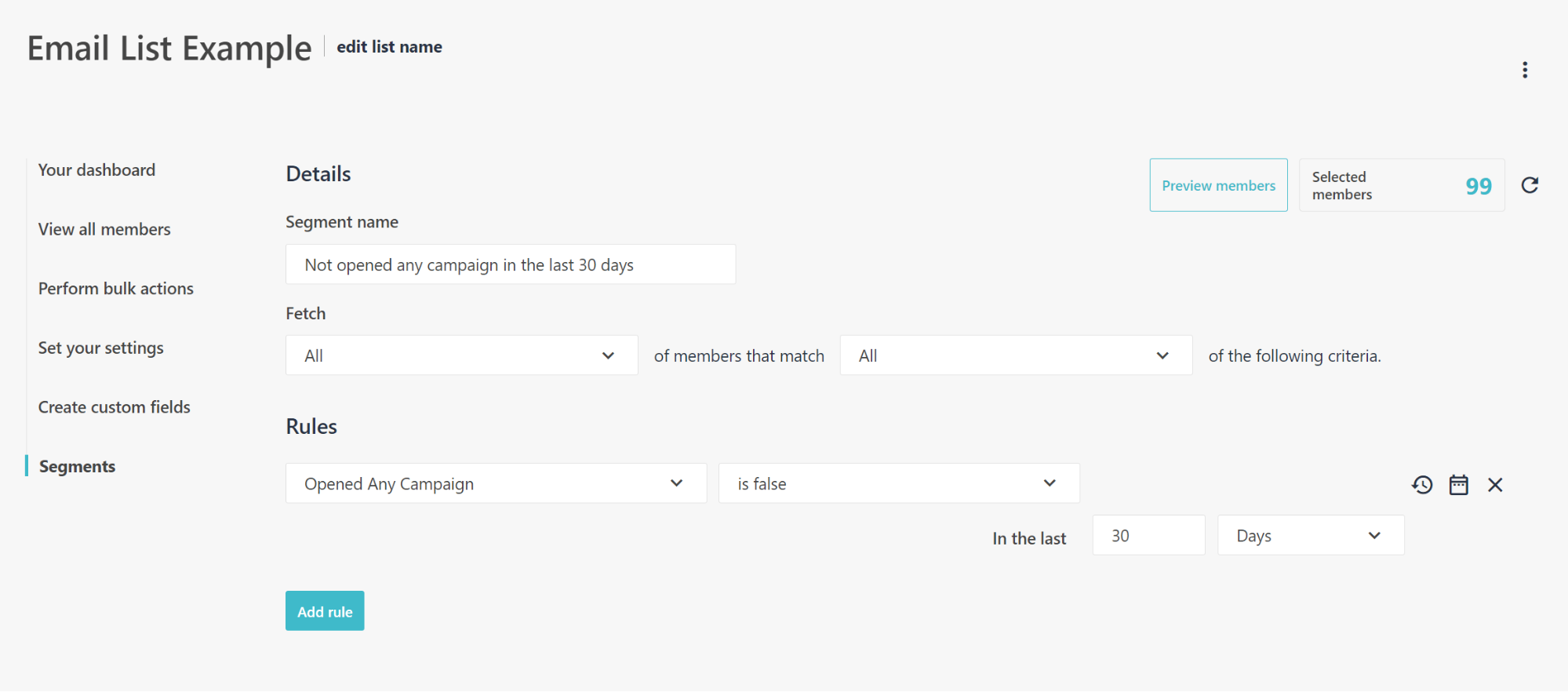
Some of the most common customer segmentation examples include:
- Age and gender
- Profession
- Birthdays
- Location
- Device type
- Inactive/hesitant customers
- Coupon lovers
Automate email sequences based on customer actions
Automation is another powerful tool for streamlining your email marketing customer journey. It ensures customers receive timely and relevant communications at every stage.
Email automation allows you to set up triggers based on specific customer actions, such as signing up for a newsletter, abandoning a cart, or completing a purchase.
This keeps your audience engaged and nurtured throughout their journey without requiring constant manual effort.
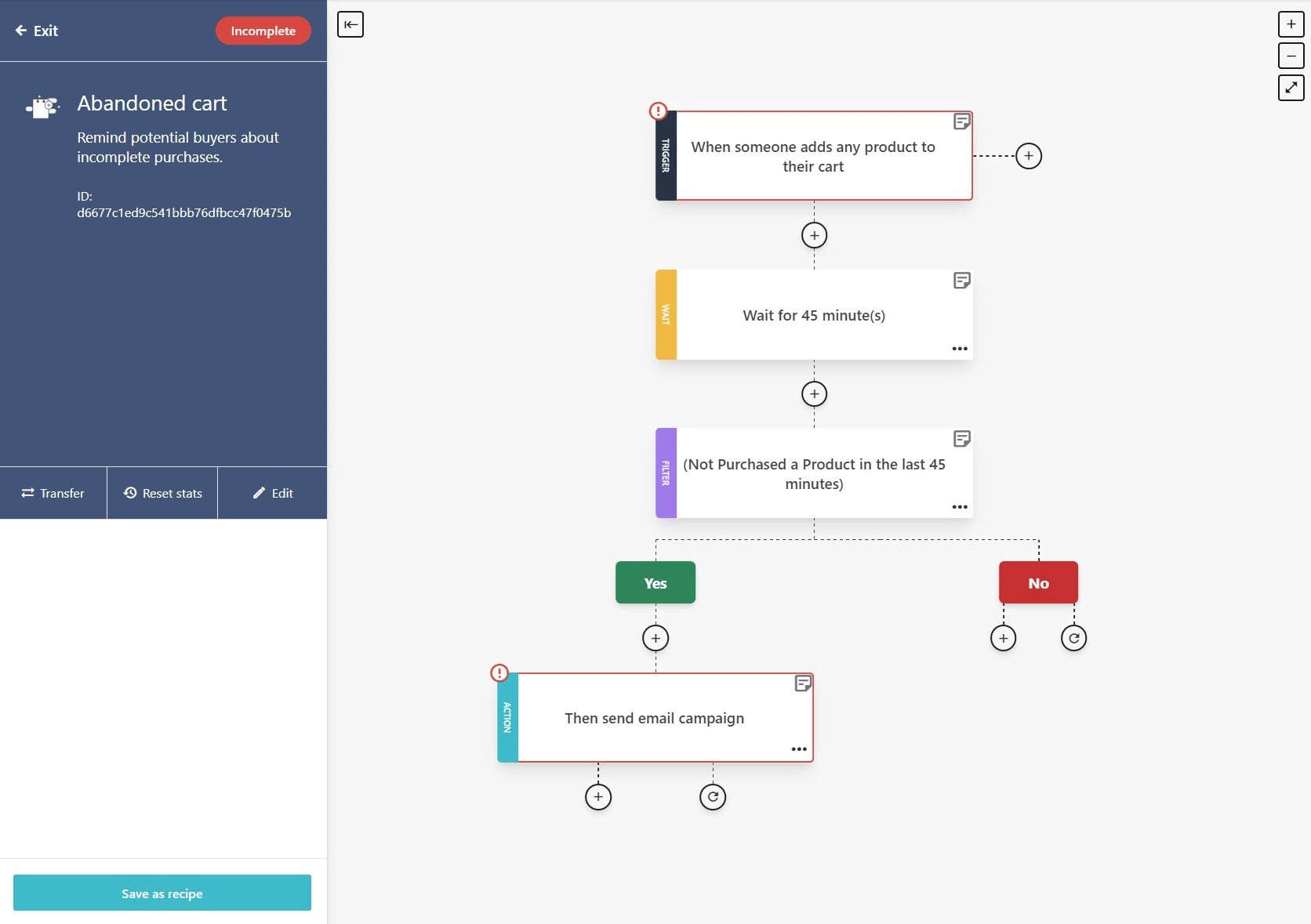
Here’s how to use automation throughout the email customer journey:
- Welcome emails: Automatically send a welcome message when a new subscriber signs up, introducing your brand and setting expectations.
- Abandoned cart emails: Trigger emails to remind customers about items left in their cart, potentially paired with a discount or free shipping offer to encourage them to complete the purchase.
- Purchase confirmations: Send order confirmation emails immediately after a transaction, including details like order summary and delivery timelines, to reassure the buyer.
- Loyalty emails: Automate reward emails for repeat customers, such as loyalty program updates or exclusive discounts for continued support.
- Re-engagement emails: Automatically send “We miss you” campaigns to inactive customers, offering incentives or updates to reignite their interest.
You can try Moosend’s automation builder to determine how easy it is to set up the above sequences for your business.
Maintain a consistent brand voice across emails
Creating a brand voice and staying consistent helps build customer recognition and trust.
A cohesive tone, style, and message at every stage—from awareness to re-engagement—ensures a seamless and unified customer experience that strengthens your brand identity.
For instance, a warm and supportive tone in abandoned cart emails can reassure hesitant buyers, while an encouraging and motivational tone in loyalty emails helps deepen customer relationships.
Because each stage of the journey serves a unique purpose, it’s essential to adapt your tone and messaging to align with the customer’s mindset and your intent at that specific stage.
- Awareness stage: Use friendly and welcoming language to introduce your brand and make a strong first impression.
- Consideration stage: Adopt a supportive and informative tone to help customers evaluate your offerings and build trust.
- Purchase stage: Keep the tone reassuring and appreciative to confirm their decision and enhance their experience.
- Loyalty stage: Show your gratitude for their support with rewards or exclusive perks.
- Re-engagement stage: Use a warm tone to reconnect with inactive customers and inspire them to return.
Ensure CTAs are clear, compelling, and easy to follow
Adding a call to action (CTA) in every email is essential for guiding customers through the journey. A well-crafted CTA provides a clear path forward, prompting them to take meaningful actions that align with their stage in the customer journey.
CTAs should use action-oriented language that inspires immediate engagement, such as:
- Click here
- Learn more
- Try our demo
- Download the app
To make your CTAs more effective, you need to match them to the purpose of each email.
For instance, in a new product release email, use “Learn More” to invite exploration. Similarly, use “Apply Discount” in a cart abandonment email to offer an incentive and drive urgency.
Here are a few more things to ace your CTAs:
- Highlight CTAs with bold colors, large fonts, or engaging button designs to capture attention.
- Use time-sensitive language like “Limited-Time Offer” or benefit-driven phrases like “Claim Your Spot Now.”
- Design CTAs to be responsive and easy to tap on mobile devices for a seamless user experience.
Design responsive email campaigns
Nobody wants to read an email with broken images, unresponsive links, or clunky formatting.
Designing emails that display seamlessly across all major devices and email apps is essential to boosting open rates, click-through rates, and overall customer perception of your brand.
Here’s what you need to keep in mind while designing emails for multiple devices:
- Use responsive templates: Choose pre-made email designs that automatically adjust to different screen sizes, including desktop, tablet, and mobile.
- Optimize visuals: Use compressed images to ensure fast loading and include alt text in case images don’t display.
- Clickable CTAs: Ensure buttons and links are large enough to easily tap on small screens.
- Font size and spacing: Use a minimum font size of 14px and sufficient line spacing for readability on mobile devices.
- Preview and test: Always test your emails on multiple devices and apps before sending them to ensure consistency.
Lastly, to ensure your emails are responsive, use your email editor’s mobile preview feature to check how they will appear on different devices.
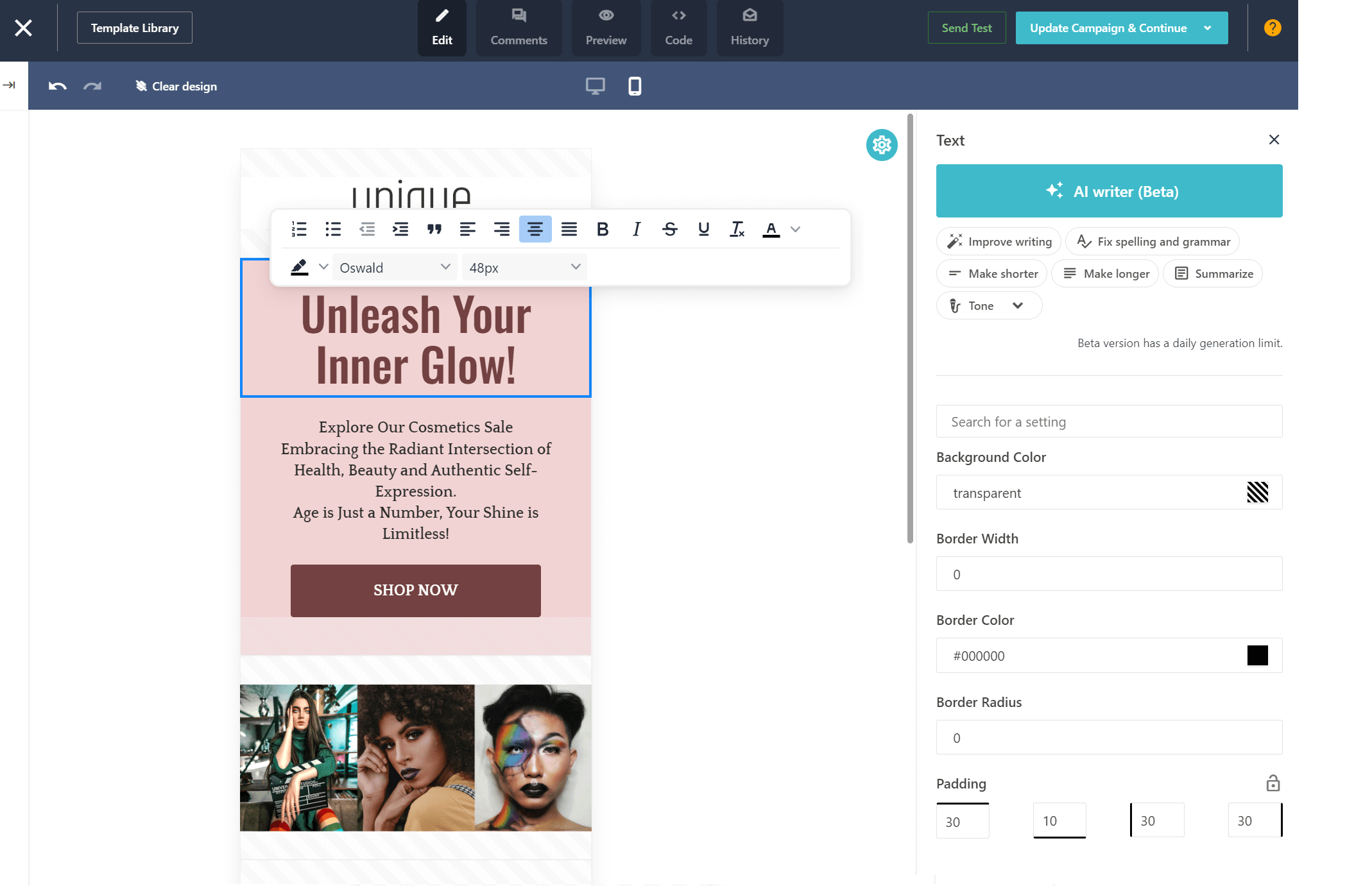
Collect valuable feedback at every stage
Feedback is essential for improving your email marketing strategy and customer journey.
At the awareness stage, ask new subscribers what content they’d like, helping you tailor emails to their preferences. In the consideration stage, follow up on abandoned carts with a quick survey to uncover barriers like pricing or insufficient details.
Post-purchase surveys in the purchase stage can also reveal insights about the buying experience, while the loyalty stage is ideal for gathering reviews or testimonials to enhance engagement.
Ask inactive customers why they stopped engaging during the re-engagement stage to refine your approach.
Feedback at each stage will help you optimize the email journey, strengthen relationships, build trust, and drive better results.
Additional resources
- Survey Email Templates for Better Response Rates
- Best Free Survey Tools [Features & Pricing]
- Effective Survey Email Subject Lines [+ Examples & Tips]
Email Campaign Examples for Each Stage of the Customer Journey
Now that we show how to map the email marketing journey and tips to enhance it, let’s see some great examples to get you inspired.
Awareness: Mammut’s welcome email
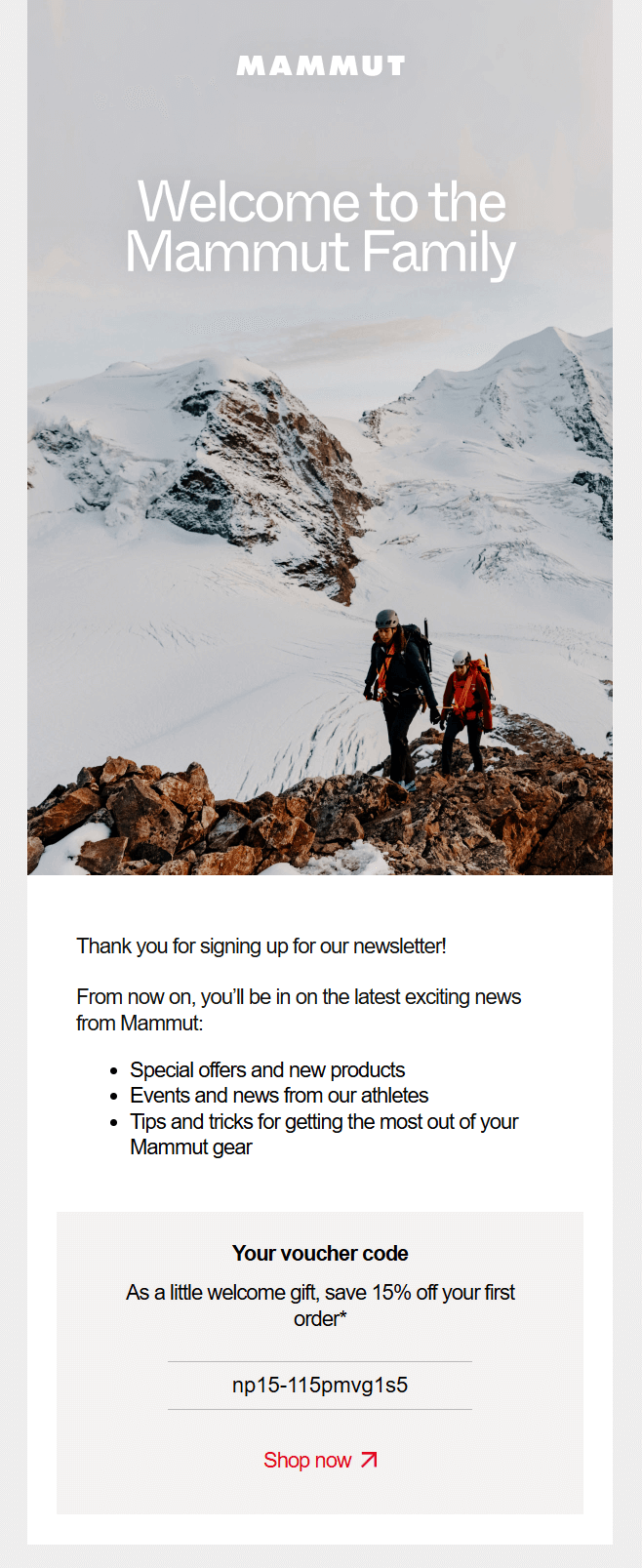
This is a great welcome email from Mammut tailored for the awareness stage.
Here’s why this email works well:
- The “Welcome to the Mammut Family” headline makes subscribers feel part of a community.
- Highlights what the subscriber will gain, such as special offers, updates, and tips to make the most of Mammut products.
- Offers a 15% discount code as a welcome gift, encouraging immediate action and building excitement around their first purchase.
- prominent “Shop Now” button makes it easy for new subscribers to take the next step.
Consideration: Skillshare’s product recommendation
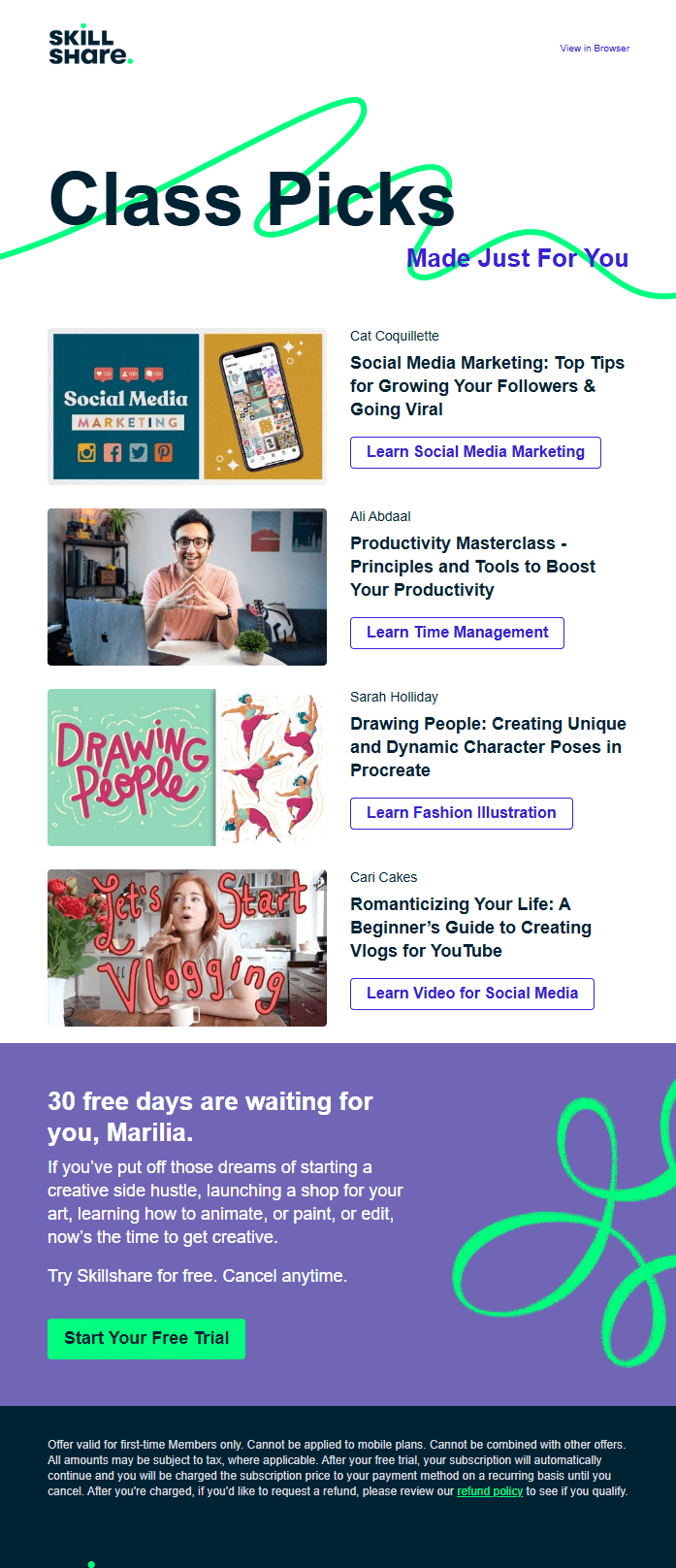
This product recommendation from Skillshare is perfect for the consideration stage as it highlights relevant options based on user preferences.
Here’s why this email works well:
- The “Class Picks Made Just For You” headline gives the impression of tailored suggestions.
- Displays diverse course options with descriptions and calls to action, catering to different interests and goals.
- The “30 free days” offer encourages users to explore without commitment, reducing hesitation.
Purchase: EA’s order confirmation email
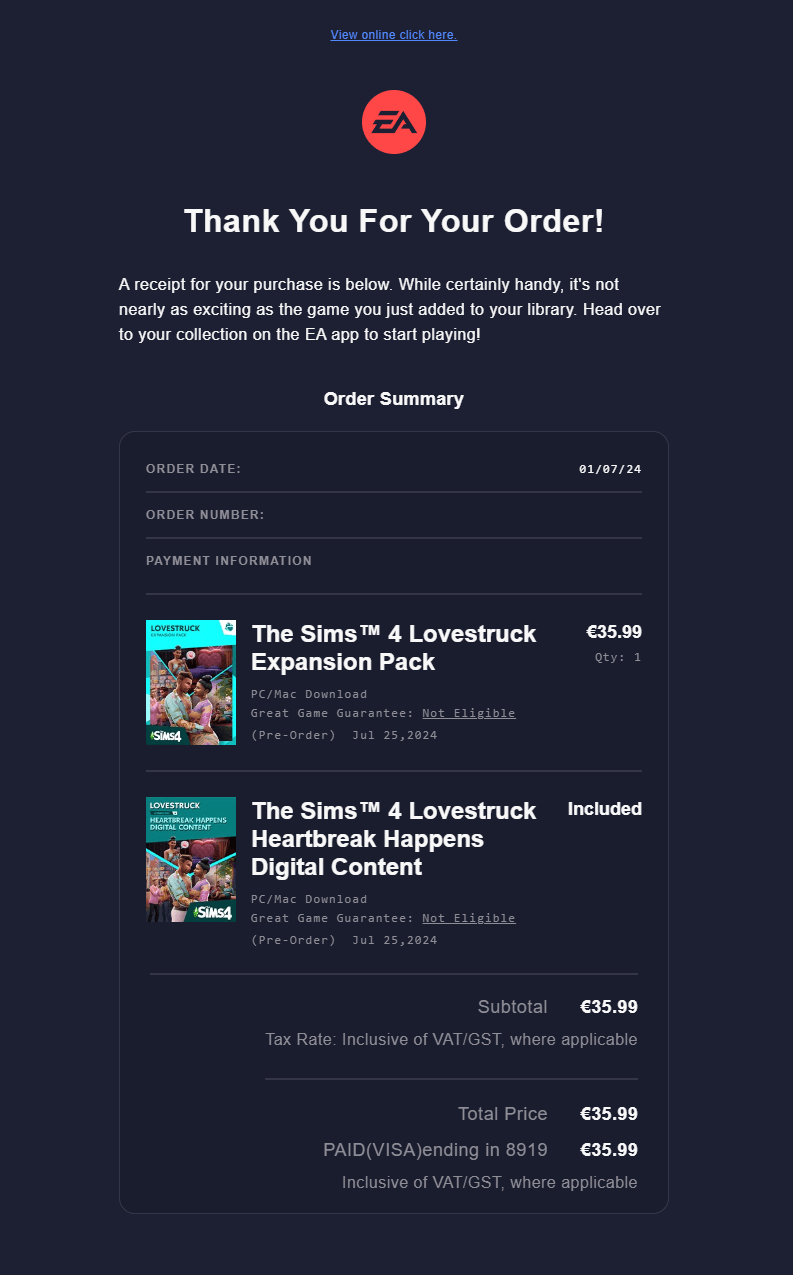
Here’s an order confirmation email for the purchase stage from Electronic Arts. It reassures the customer about their transaction and provides the necessary details to proceed smoothly.
Here’s why this email works effectively:
- The message confirms the purchase, immediately putting the customer at ease.
- Detailed information about the purchased items, payment, and download availability ensures the customer knows exactly what to expect.
- Encourages customers to access their game via the EA app, guiding them toward the next action.
- The clean layout with organized sections makes locating critical information, such as the order date, number, and total price, easy.
Loyalty: MAC’s loyalty program
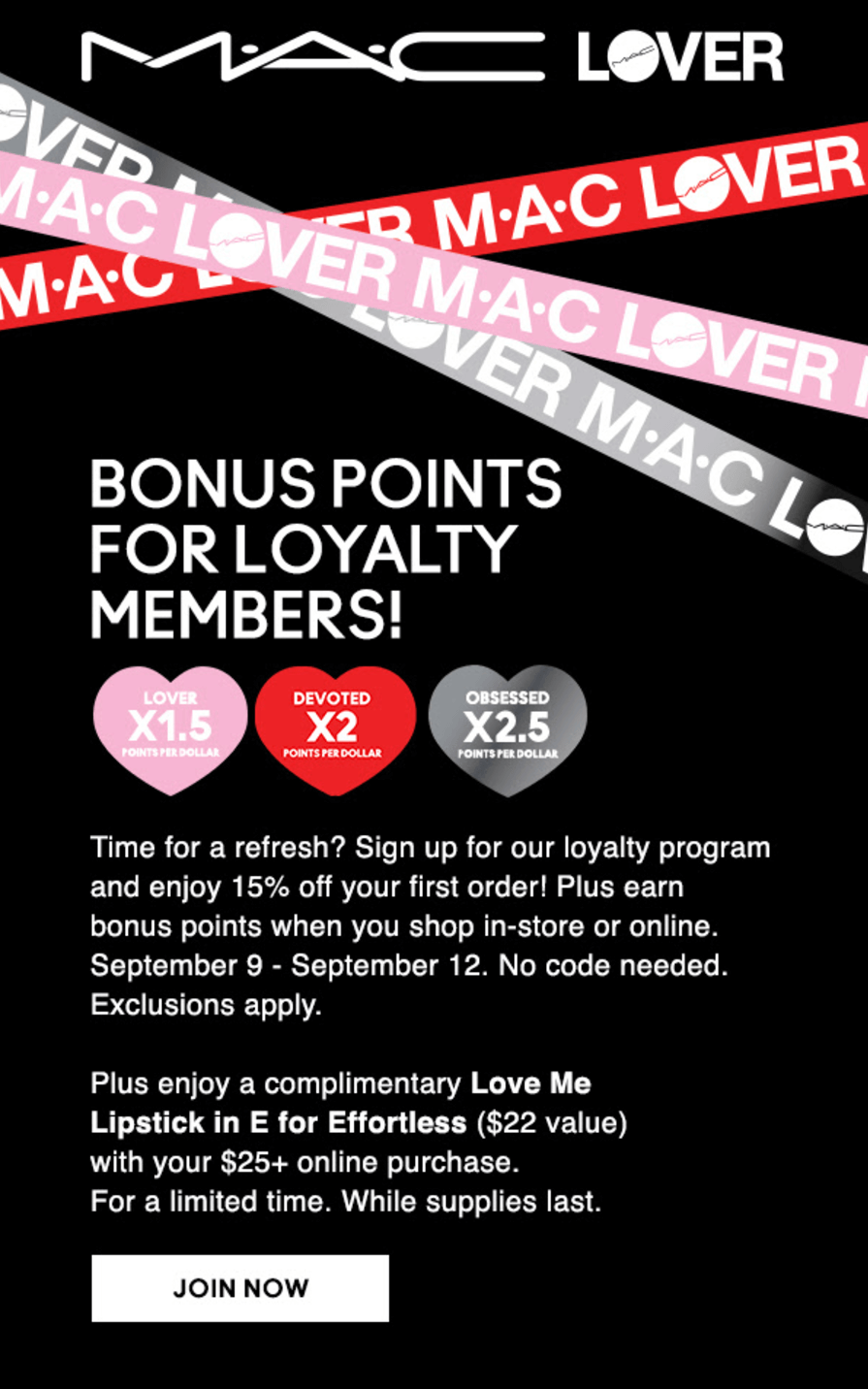
MAC Cosmetics’ email marketing campaign motivates continued engagement with the brand while rewarding loyalty.
Here’s why it works:
- The email copy emphasizes the benefits of being a member, highlighting a tiered reward system (1.5x, 2x, 2.5x points) that encourages higher spending for greater rewards.
- Offers a 15% discount on the first order and a complimentary lipstick with a $25+ purchase, adding value for loyalty members.
- Promotes urgency with specific dates (September 9 – 12) and “while supplies last,” motivating customers to act quickly.
- The “Join Now” button is simple, bold, and action-oriented, making it easy for customers to sign up or re-engage with the program.
Re-engagement: Fila’s ‘We’ve missed you’
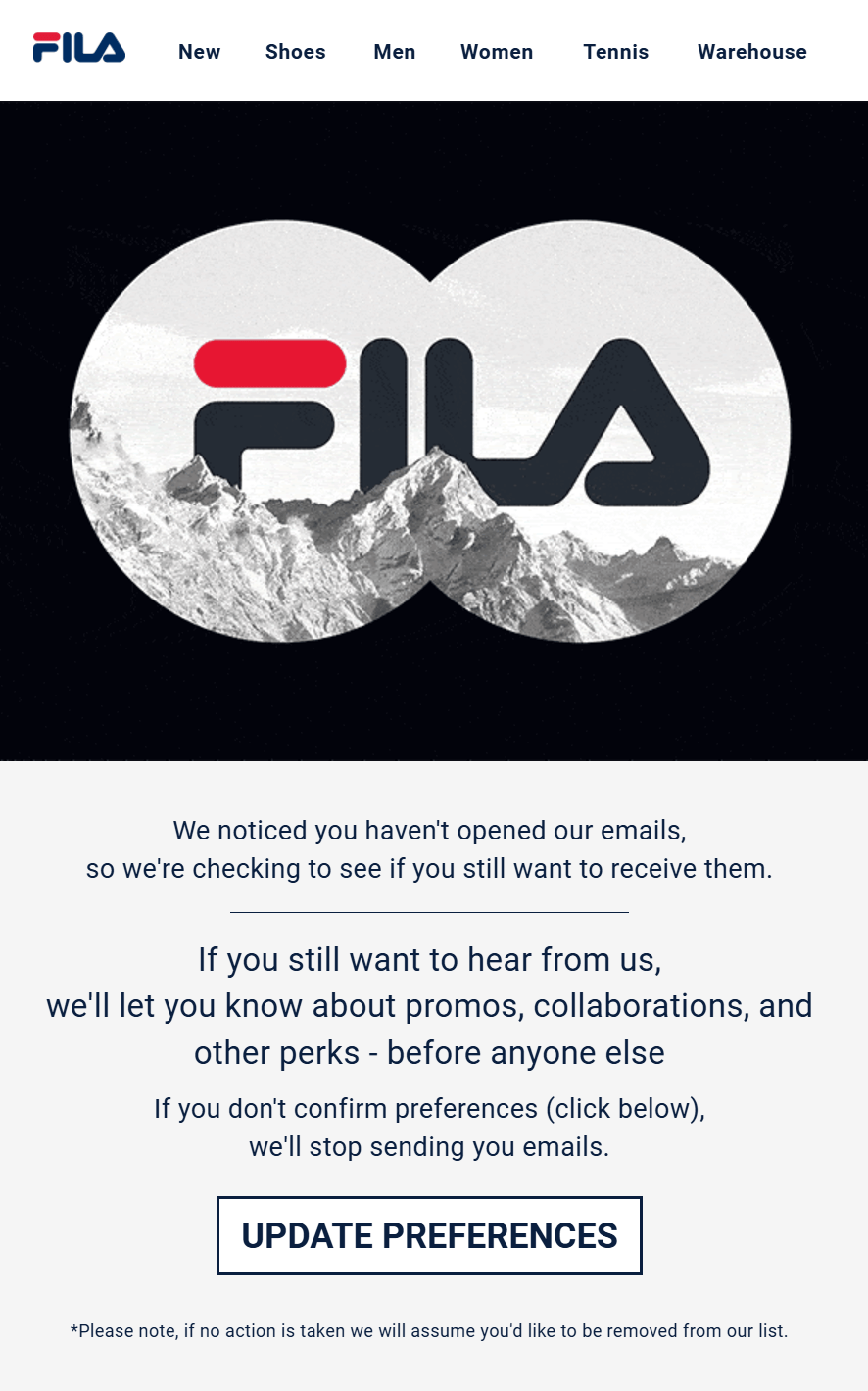
This re-engagement email from Fila addresses inactivity while offering value to entice the recipient to reconnect.
Encouraging users to visit the preference center allows them to update their email preferences and opt into the most relevant content.
Here’s what works:
- Opens with a clear message, “We noticed you haven’t opened our emails,” showing attentiveness without being intrusive.
- The CTA button makes it easy for recipients to tailor their email preferences to suit their interests, increasing the likelihood of re-engagement.
- Provides an opt-out option without pressure, demonstrating consideration for the recipient’s preferences.
- Subtly implies that inaction will lead to being removed from the list, prompting an immediate response.
Create an Effective Email Marketing Customer Journey
Email marketing is more than just a tool—it’s the foundation of a meaningful customer journey.
When you understand your audience and anticipate their needs, you can deliver the right message at the right time, transforming casual subscribers into loyal customers and advocates.
But the journey doesn’t stop at the sale. Every email, every interaction, and every moment is an opportunity to build deeper connections and inspire trust.
Remember, great email marketing isn’t about cluttering inboxes—it’s about creating memorable experiences that resonate long after the click. Brands that embrace this approach don’t just grow; they build lasting relationships that define their success.
If you want to enhance your email marketing journey, you can take a look at Moosend’s platform and see how you can turn simple messages into meaningful interactions throughout the customer journey.
FAQs
Below, let’s see some common questions about the email marketing customer journey.
1. How to build an email journey?
To build an effective email journey, follow a few simple steps:
- Identify your audience and segment them based on demographics or behavior.
- Map out the stages of the customer journey: awareness, consideration, purchase, loyalty, and re-engagement.
- Create content tailored to each stage, such as welcome emails, cart reminders, and loyalty rewards.
- Use automation tools to trigger emails based on customer actions, like sign-ups or purchases.
- Test and optimize email performance to refine your journey over time.
2. What is the email journey flow?
The email journey flow is the sequence in which emails are sent to customers, triggered by their actions or stages in the journey. A typical flow includes:
- Welcome emails (triggered by sign-ups) for the awareness stage.
- Nurture emails (triggered by browsing or cart activity) for the consideration stage.
- Purchase confirmation and follow-ups (triggered by purchases) for the purchase stage.
- Loyalty messages (scheduled regularly) to reward repeat customers.
- Re-engagement campaigns (triggered by inactivity) to win back dormant customers.
This flow ensures that each email aligns with the customer’s needs and actions.
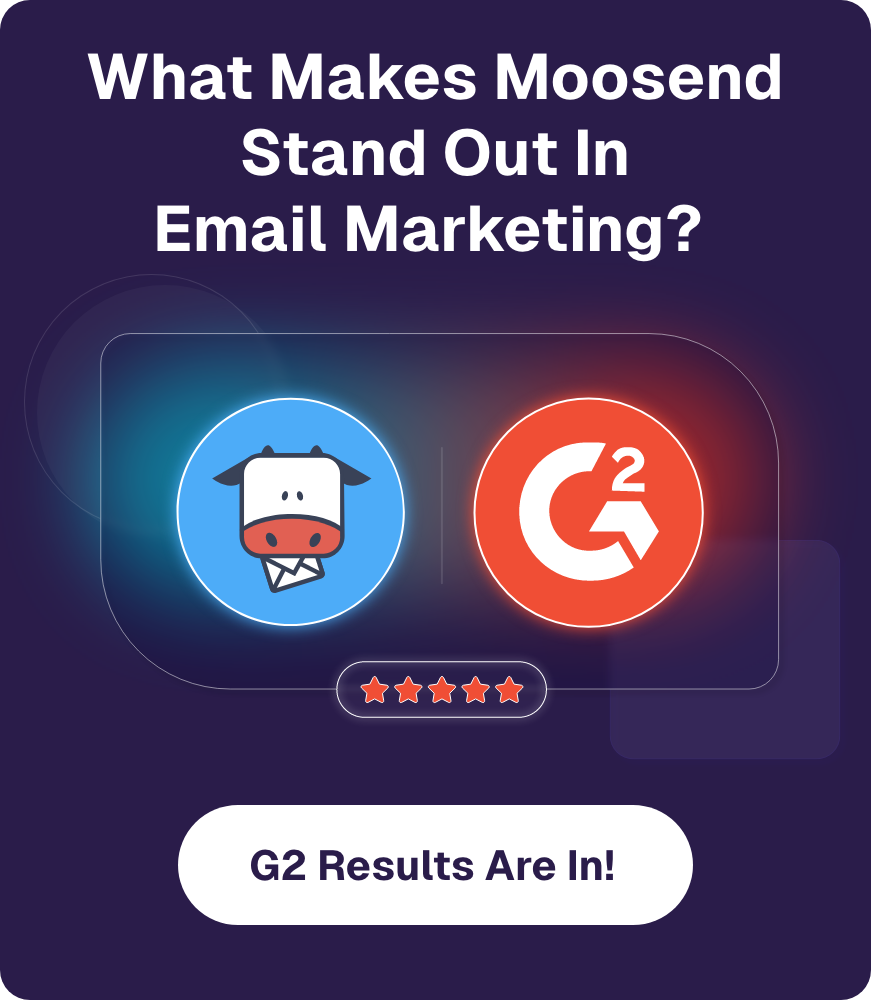
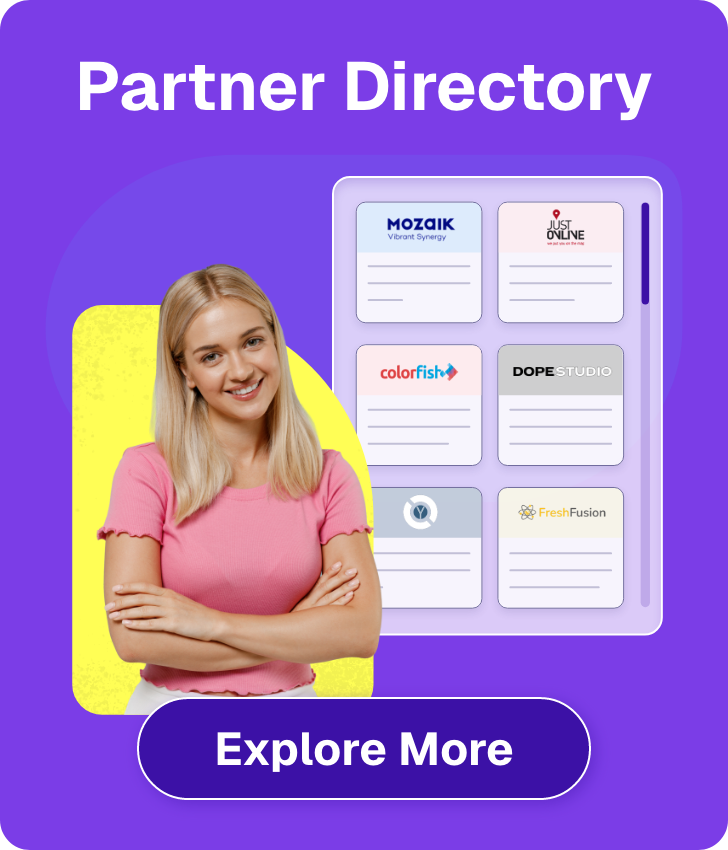


 Published by
Published by